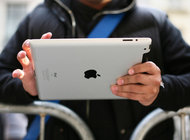 Chris Ratcliffe/Bloomberg News
Chris Ratcliffe/Bloomberg News
10:29 a.m. | Updated Adding more details as the press conference progresses.
Apple wants students to bid farewell to the days of lugging around backpacks of heavy textbooks, and to welcome the iPad tablet as their new all-in-one reading device.
On Thursday the company released iBooks 2, a free app that will support digital textbooks that can display interactive diagrams, audio and video. At a news conference, the company demonstrated a biology textbook featuring 3-D models, searchable text, photo galleries and flash cards for studying. Apple said high school textbooks from its initial publishing partners, including Pearson, McGraw-Hill and Houghton Mifflin Harcourt, would cost $15 or less.
“Education is deep in our DNA and it has been from the very beginning,” said Philip W. Schiller, Apple’s senior vice president of marketing, at the event at the Solomon R. Guggenheim Museum in New York.
Apple also announced a free tool called iBooks Author, a piece of Macintosh software that allows people to make these interactive textbooks. The tool includes templates designed by Apple, which publishers and authors can customize to suit their content. It requires no programming knowledge and will be available Thursday.
The company also unveiled the iTunes U app for the iPad, which allows teachers to build an interactive syllabus for their coursework. Students can load the syllabus in iTunes U and, for example, tap to open an electronic textbook and go directly to the assigned chapter. Teachers can use iTunes U to create full online courses with podcasts, video, documents and books.
Apple’s push into textbooks brought with it far less buzz than is usual with the company’s new product announcements, in part because of an unusual spoiler. In “Steve Jobs,” the biography that was published in October shortly after Apple’s former chief executive died, Mr. Jobs declared that he wanted to transform the textbook market with the iPad.
Mr. Jobs told the book’s author, Walter Isaacson, that he wanted to hire well-known textbook writers to create electronic versions of their books. He said that Apple could sidestep the state certification process for K-12 textbooks by making them available free for iPads.
By most estimates, Apple has not captured as much of the electronic book market with the iPad and its iBookstore as its chief rival in the business, Amazon, has with the Kindle e-reader.
But while Amazon was a much earlier entrant into the e-books business, it has been less successful in the education market.
Amazon in 2009 announced plans to target the textbook publishing industry with the Kindle DX, a larger version of its e-reader. Not only did Amazon fail to make a dent in the digital textbook market, it also did not impress students. For instance, at Princeton, one of the universities that offered a Kindle DX pilot program, students complained about the device’s sluggishness, lack of color and limited interactivity, according to the university’s student newspaper, The Daily Princetonian.
Education is where Apple has an advantage against Amazon. Apple has a deep and longstanding connection with the education market that could serve it well as it enters the textbook business. Even as its Macintosh computers were shunned by big purchasers of technology inside corporations in decades past, Apple found success selling them to K-12 schools and colleges.
The advent of the iPad and iPhone, along with a resurgence in the growth of the Mac, has made Apple products an even more ubiquitous sight on campuses than they are in the general population.
Before Apple formed official partnerships with textbook publishers, some universities had already embraced the iPad as an experimental learning tool for the classroom. In 2010, Seton Hill University, George Fox University and Abilene Christian University began pilot programs, in which students received iPads as part of their tuition and instructors were trained to use mobile software to teach their courses.
The base price of an iPad is $500, but that cost is inconsequential when considering the lower prices of digital textbooks purchased through iBooks, says Bill Rankin, a professor of medieval studies at Abilene Christian University. In 2008, Mr. Rankin helped start a pilot program in his school where students and teachers used iPhones in the classroom. He explained that textbook publishers typically mark up the prices of print textbooks by six times, because they predict the books will be resold six times, and therefore students would quickly get their money’s worth after purchasing iPads.
Mr. Rankin predicted that with digital textbooks, publishers will realize they can sell more titles for less money, which would drive down overall costs of textbooks both in print and digitally.
He called Apple’s new education apps and tools “revolutionary,” because they give teachers, authors and publishers the ability to create and share books easily. He compared this to how Apple’s App Store democratized the way software was distributed.
“This is something we’ve been dreaming about for years,” he said. “And to see the first steps of this being realized is immensely exciting.”
However, an executive at CourseSmart, an electronic textbook provider that offers digital textbooks for the iPad, iPhone and Android devices, said in response to Apple’s announcements that it was an issue that the company’s digital textbooks would be exclusively available for Apple products.
“Based on the fact that you have to mandate a specific device, that’s going to be difficult for school districts to decide students are going to take their strained budgets to purchase these devices,” said Jill Ambrose, chief marketing officer at CourseSmart, in an interview.
Article source: http://feeds.nytimes.com/click.phdo?i=d0149bbe4bc32a38fb70888dd19d4294
Speak Your Mind
You must be logged in to post a comment.